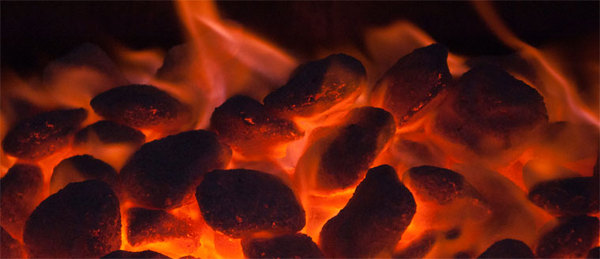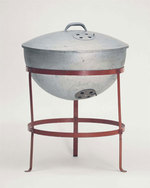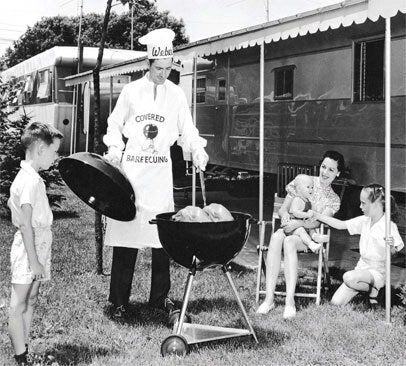
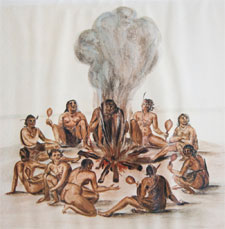 Grilling has been around since the first time a forest fire trapped a wild hog and a band of homo erectus hunters noticed a wonderful scent wafting from the rubble.
Grilling has been around since the first time a forest fire trapped a wild hog and a band of homo erectus hunters noticed a wonderful scent wafting from the rubble.
It probably wasn't long before the tribe threw fresh meat on the coals of a campfire, and soon thereafter devised a grid of green sticks to hold the meat above the yucky ashes. The technology progressed to open pits dug in the ground, rotisseries in front of indoor fireplaces, and brick ovens in campgrounds and back yards.
In 1897 Ellsworth Zwoyer patented the charcoal briquet. It really took off when, in the 1920s, Henry Ford, in collaboration with Thomas Edison and EB Kingsford, began commercial manufacturing by making them from sawdust and wood scraps from Ford's auto plants in Detroit. (Click here for more about charcoal.)
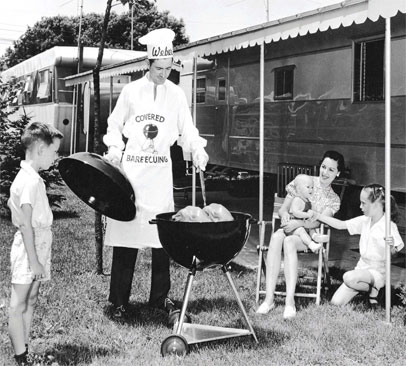 In 1948 George Hasty introduced the Hasty Bake, a grill on wheels that burned charcoal. Something similar is still built by the Oklahoma company today.
In 1948 George Hasty introduced the Hasty Bake, a grill on wheels that burned charcoal. Something similar is still built by the Oklahoma company today.
But the innovation that made grilling and cooking outdoors the great American pastime came in 1951 when George Stephen, Sr., frustrated by his inability to control the heat in his backyard grill, had the welders at the Weber Brothers Metal Works, where he worked, cut up a buoy that was to be used for Lake Michigan boating. The Weber Kettle was born and introduced in 1952. Among its innovations was a tight-fitting lid and adjustable air vents that allowed the cook to control temperature. Today's design is not far from the original and it is by far the most popular backyard grill in the world with the basic unit selling for under $100. (Click here for more about the history of barbecue and grilling.)
 The body and lid of the modern Weber Kettle is pressed from solid sheets of steel so there are no welds to rust, and coated with a durable powder coated baked on porcelain enamel that lasts for decades. The lower intake vents double as an ash collection system and the three legs with two wheels make rolling it around a snap. It is lightweight, there are few parts, and simplicity reigns. There are now four sizes, the Smokey Joe with a 14.5" diameter grill surface, the 18.5" kettle, the 22.5" kettle, the 26.75" kettle, and the Weber Ranch Kettle which is 37.5" diameter. They also have upscale versions in colors with a side cutting board, an ash collection pot, and even a propane ignition system. The most popular is the plain old three leg 22.5", by far. In black.
The body and lid of the modern Weber Kettle is pressed from solid sheets of steel so there are no welds to rust, and coated with a durable powder coated baked on porcelain enamel that lasts for decades. The lower intake vents double as an ash collection system and the three legs with two wheels make rolling it around a snap. It is lightweight, there are few parts, and simplicity reigns. There are now four sizes, the Smokey Joe with a 14.5" diameter grill surface, the 18.5" kettle, the 22.5" kettle, the 26.75" kettle, and the Weber Ranch Kettle which is 37.5" diameter. They also have upscale versions in colors with a side cutting board, an ash collection pot, and even a propane ignition system. The most popular is the plain old three leg 22.5", by far. In black.
I asked my associate, Dr. Greg Blonder, a physicist and the former head of research at Bell Labs, about the Kettle's cooking properties. He said "Most people believe the Weber is a parabolic reflector, focusing heat emitted by the coals directly on the grill. A parabolic reflector is only effective when the heat source is tiny, intense and located at the focal point. This is not true in the case of the Weber, where the heat source is a sheet of coals spread over a large area.
"On the other hand, the Weber gets many things right. While the parabola won't create a beam of infra-red energy, the high almost vertical side walls reflect the infra-red image of the coals from side to side- like images of your head pinging back and forth between two mirrors at the barbershop. So this 'reflection gallery effect' does increase the heat intensity a bit compared to cooking over an open pit, where heat emitted to the sides is lost. The system is efficient, burning a minimum number of briquets during cooking."
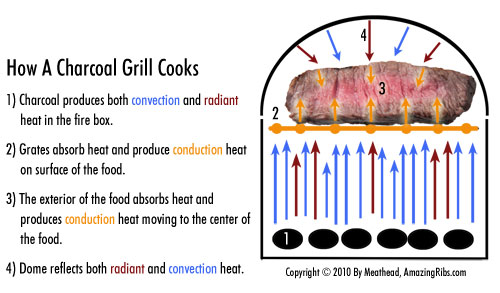
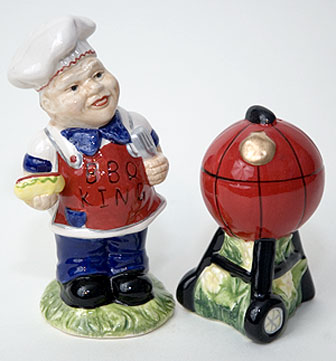 Alas, most cooks never quite figure out the thermodynamics of grilling and they tend to cover the whole bottom with hot coals. This can raise the air temp at the cooking surface to well over 500F, a recipe for incineration if the cook wanders off for long. But if cooks learn to bank the coals to one side and cook mostly with smoky convection air on the indirect side first and then sear over the direct radiant heat side at the end of the cook, they could up their game significantly. Click here for an article on how to best set up a Weber Kettle for grilling and smoking, click here for a better understanding of the thermodynamics of grilling, and click here to learn about searing at the end of a cook.
Alas, most cooks never quite figure out the thermodynamics of grilling and they tend to cover the whole bottom with hot coals. This can raise the air temp at the cooking surface to well over 500F, a recipe for incineration if the cook wanders off for long. But if cooks learn to bank the coals to one side and cook mostly with smoky convection air on the indirect side first and then sear over the direct radiant heat side at the end of the cook, they could up their game significantly. Click here for an article on how to best set up a Weber Kettle for grilling and smoking, click here for a better understanding of the thermodynamics of grilling, and click here to learn about searing at the end of a cook.
There are better designs for grills, among them the top end Hasty Bakes, and there are cheaper grills, but the modern Weber Kettle has achieved icon status while Hasty Bake is often confuse with the Easy Bake oven, a child's toy. The familiar profile has become a symbol for all grills and it appears in pop culture from salt & pepper shakers to Teleflora flower pots. Probably no other single invention has influenced the American diet since the refrigerator.
How old is your Weber Kettle?
All text and some photos are Copyright (c) 2012 By Meathead, and all rights are reserved. For more of Meathead's writing, photos, recipes, and barbecue info please visit his website AmazingRibs.com and subscribe to his email newsletter, Smoke Signals.
Friend Meathead on Facebook: http://www.facebook.com/AmazingRibs
